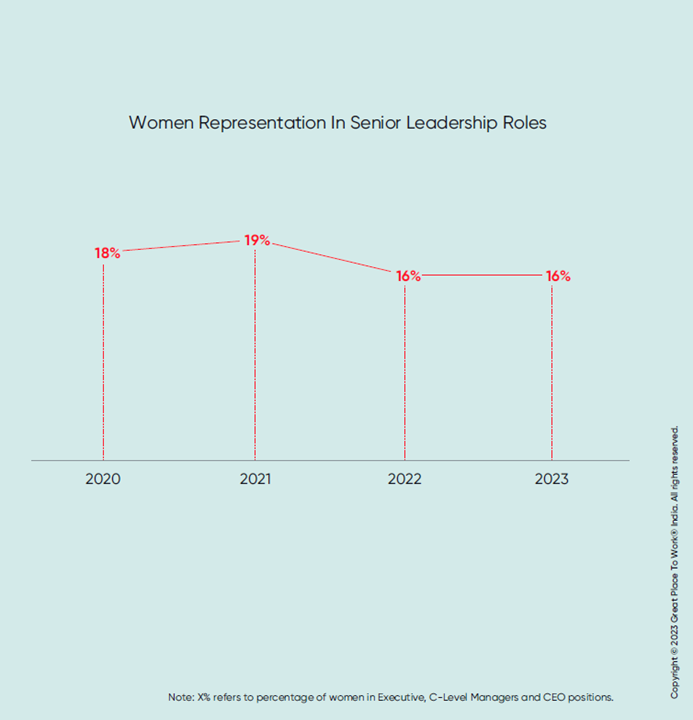Reading Time: 4 minutes
In the complex tapestry of administrative leadership, a prevailing issue demands our attention—the stark gender disparity entrenched in leadership roles. This concern is notably conspicuous in India, where female leaders often find themselves assessed against male leadership benchmarks. The gender gap isn’t confined to any specific sector but is particularly pronounced in the educational landscape. As we navigate the intricate layers of this issue, it is paramount to shed light on the statistics that underscore the gravity of gender disparity.
The Current Landscape:
A research article from the Journal of the International Society for Teacher Education reveals a disquieting reality—only 35% of academics in India are women, and an even smaller fraction ascend to leadership positions. These figures not only depict a gendered imbalance in educational leadership but also reflect broader societal norms perpetuating such disparities.
According to the 2023 Gender Social Norms Index (GSNI) report by the United Nations Development Programme (UNDP), gender bias is a pervasive global problem. The GSNI quantifies biases against women in key dimensions—political, educational, economic, and physical integrity. Alarmingly, close to 9 out of 10 individuals, regardless of gender, harbor fundamental biases against women. The report reveals that nearly half of the global population believes men make better political leaders, and two out of five people perceive men as more competent business executives than women. These biases persist across various regions, income levels, and cultures, underscoring the global nature of this issue.
Despite increased awareness and efforts to address gender inequality, the UNDP’s Gender Inequality Index (GII) has remained stagnant since 2019. This lack of progress emphasizes the need for concrete actions to dismantle the systemic barriers hindering women’s progress in various spheres of life.
Corporate Landscape:
Shifting our focus to the corporate realm, the latest Women in the Workplace report from McKinsey for 2023 indicates modest gains in women’s representation throughout the corporate pipeline. However, the report highlights a persistent underrepresentation of women of color. According to the Insights from our India’s Best Workplaces for Women 2023 report, women’s evolving roles, skills, and contributions enrich corporate diversity, innovation, and success.

The representation of women in the corporate world has seen a positive trajectory, climbing from 21% in 2021 to 26% in 2023. Yet, the representation of women in executive, C-level management, and CEO positions in India has remained stagnant at 16% over the past two years, underscoring the urgent need for enhanced gender diversity in leadership roles.
Dismal Statistics:
Delving deeper into the numbers, we find that only 8% of CEOs in Indian organizations are women. Furthermore, a concerning statistic reveals that 31% of women lack female peers in senior leadership positions within their organizations. These figures illuminate the challenges that women face as they climb the corporate ladder, emphasizing the urgency of addressing gender disparities at the highest echelons of leadership.

Strategies for Change:
While many organizations actively pursue increased gender representation, true leaders in this endeavor recognize the importance of simultaneously prioritizing a positive and inclusive workplace experience for all female employees. To foster gender equity, organizations can adopt the following strategies:
1. Gender Proportionality Principle:
Implementing policies and practices that ensure gender proportionality across all levels of an organization, from entry-level positions to executive roles. This involves proactive recruitment efforts to balance gender representation.
2. De-bias Your Workplace:
Conducting bias training and fostering a workplace culture that actively challenges and dismantles gender biases, promoting an environment of inclusivity and equal opportunities. Organizations can invest in educational programs to raise awareness about unconscious biases.
3. Be Transparent About Wage Gaps:
Promoting transparency regarding salary structures and ensuring that gender wage gaps are addressed promptly. This transparency not only builds trust but also holds organizations accountable for pay equality. Pay audits regularly can assist in locating and addressing inequalities.

4. Bring Flexibility to the Work Environment:
Recognizing and accommodating the diverse needs of a workforce by introducing flexible work hours and remote work options. This not only aids in work-life balance but also dismantles traditional gender roles. Organizations can establish flexible policies that support employees in balancing professional and personal responsibilities.
5. Embrace Non-Linear Career Paths:
Encouraging and supporting non-linear career trajectories for employees, especially women. Acknowledging that career progression may not always follow a linear path and creating opportunities for individuals to grow and advance at their own pace. This involves mentoring programs, skill development initiatives, and policies that allow for career breaks and re-entry.
6. Invest in Leadership Development Programs for Women:
Establishing targeted leadership development programs for women to equip them with the skills and confidence needed to advance in their careers. This entails training courses, coaching, and mentorship that are specifically designed to meet the special difficulties that women in leadership encounter.
7. Promote Inclusive Decision-Making Processes:
Actively involving women in decision-making processes at all levels of the organization. This includes creating diverse leadership teams, ensuring representation on boards, and seeking input from women in strategic initiatives.
As we unveil the gender disparity in Indian leadership, it becomes evident that systemic changes are imperative for creating a more equitable future. The statistics paint a sobering picture, emphasizing the urgent need for organizations and society at large to address these disparities head-on. By adopting proactive strategies, fostering inclusivity, and challenging ingrained biases, we can pave the way for a future where leadership is truly diverse, representative, and reflective of the rich tapestry of talent that exists in our society.
It is not just a call for change; it is a call for a transformation that transcends gender and propels us toward a more inclusive and equitable future. The journey toward gender equality in leadership is a collective responsibility requiring sustained efforts from individuals, organizations, and policymakers. As we move forward, let us strive for a reality where every individual, irrespective of gender, has the opportunity to contribute and thrive in leadership roles, shaping a world where diversity is celebrated, and equality is not just a goal but a lived reality.





